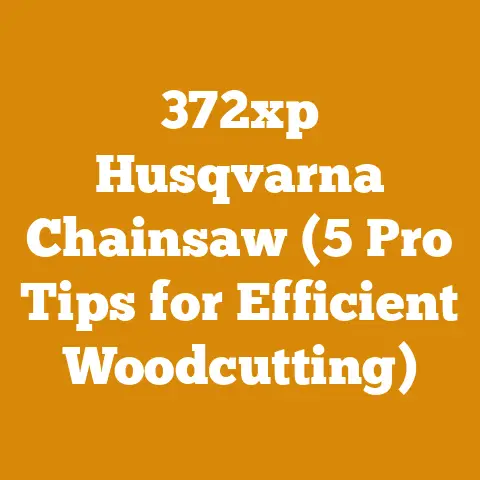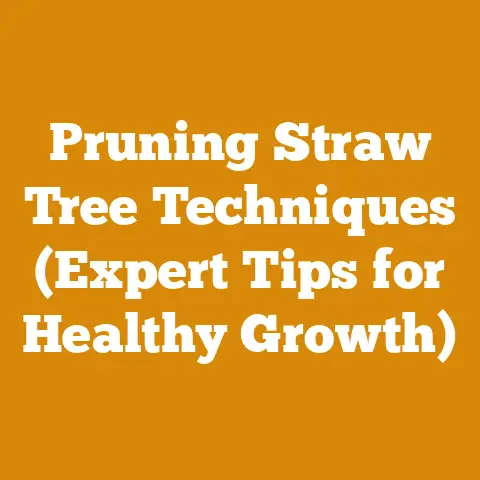Price of Firewood per Cord (5 Insider Tips for Maximizing Profit)
It seems counterintuitive, doesn’t it? The more effort you put into splitting and stacking firewood, the less money you might actually make. That’s the paradox I’ve wrestled with for years in the firewood business. Maximizing profit in the firewood game isn’t just about brute strength; it’s about strategy, efficiency, and understanding your market. Selling firewood might seem simple, but turning it into a lucrative venture requires a keen eye for detail and a willingness to adapt. Let me share some hard-earned wisdom – the kind you only get from years of sweating in the woods and crunching the numbers.
Price of Firewood per Cord: 5 Insider Tips for Maximizing Profit
The firewood business can be a tough nut to crack, but with the right approach, it can be a reliable source of income. Over the years, I’ve learned that the price of firewood per cord isn’t just pulled out of thin air. It’s a delicate balance of costs, market demand, and perceived value. These five insider tips are designed to help you navigate those complexities and boost your profits.
1. Accurately Calculate Your Costs: The Foundation of Profitability
Before you even think about setting a price, you need to know your costs. This is where many firewood sellers stumble. They underestimate the true cost of production, leading to lower profits or even losses. I’ve seen it happen time and time again.
Breaking Down the Costs
Your costs can be broken down into two main categories: fixed costs and variable costs.
-
Fixed Costs: These are costs that remain relatively constant regardless of how much firewood you produce. Examples include:
- Land Rental or Mortgage: If you’re using land for your operation, factor in the monthly or annual cost. Even if you own the land outright, consider the opportunity cost – what else could you be doing with that land?
- Equipment Depreciation: Chainsaws, log splitters, trucks – they all wear down over time. Calculate the annual depreciation cost of each piece of equipment. For example, if you bought a log splitter for $2,000 and expect it to last 5 years, the annual depreciation cost is $400.
- Insurance: Liability insurance is essential to protect yourself from accidents.
- Permits and Licenses: Depending on your location, you may need permits to harvest wood or sell firewood.
-
Variable Costs: These costs fluctuate depending on how much firewood you produce. Examples include:
-
Raw Material (Wood): Are you buying logs, or are you harvesting them yourself? If buying, track the cost per cord or per truckload. If harvesting, factor in the cost of fuel, chainsaw oil, and replacement parts. I always keep a detailed log of my fuel consumption.
- Fuel: This is a major variable cost. Track the fuel used for your chainsaw, log splitter, truck, and any other equipment.
- Labor: If you’re hiring help, factor in the hourly wage and any associated costs like payroll taxes. Even if you’re doing all the work yourself, consider the value of your time. What else could you be doing with those hours?
- Maintenance and Repairs: Chainsaws break down, tires go flat, and log splitters need servicing. Factor in the cost of parts and labor for repairs. I set aside a percentage of my income each month specifically for equipment maintenance.
- Marketing and Advertising: Whether it’s flyers, online ads, or simply gas money for driving around and posting signs, marketing costs money.
- Packaging and Delivery: If you’re selling bundled firewood or delivering cords, factor in the cost of twine, plastic wrap, and delivery fuel.
- Taxes: Don’t forget to factor in any applicable sales taxes or income taxes on your firewood sales.
Calculating the Cost per Cord
Once you’ve identified all your costs, you need to calculate the cost per cord. Here’s how:
- Calculate Total Fixed Costs: Add up all your fixed costs for a specific period (e.g., one year).
- Estimate Production Volume: Estimate how many cords of firewood you expect to produce during that same period.
- Calculate Fixed Cost per Cord: Divide your total fixed costs by your estimated production volume.
- Calculate Total Variable Costs: Add up all your variable costs for a specific period, based on your estimated production volume.
- Calculate Variable Cost per Cord: Divide your total variable costs by your estimated production volume.
- Calculate Total Cost per Cord: Add your fixed cost per cord and your variable cost per cord.
Example:
Let’s say your annual fixed costs are $5,000, and you estimate producing 100 cords of firewood. Your fixed cost per cord is $50.
Your variable costs per cord are:
- Wood: $40
- Fuel: $20
- Maintenance: $10
- Labor (if applicable): $30
Your total variable cost per cord is $100.
Therefore, your total cost per cord is $50 (fixed) + $100 (variable) = $150.
Takeaway: Accurately calculating your costs is the first step to setting a profitable price. Don’t underestimate any expenses.
Next Step: Create a detailed spreadsheet to track all your costs. Review it regularly and adjust your pricing as needed.
2. Know Your Market: Demand, Competition, and Customer Preferences
The price of firewood isn’t just about your costs; it’s also about what people are willing to pay. Understanding your local market is crucial for maximizing profit.
Assessing Demand
Demand for firewood fluctuates depending on the season, weather patterns, and local economy.
- Seasonality: Demand is highest during the fall and winter months when people are using firewood for heating. Summer months typically see lower demand. I often offer discounts during the off-season to keep cash flowing.
- Weather: A particularly cold winter will drive up demand and prices. Keep an eye on weather forecasts and adjust your inventory accordingly. A mild winter can leave you with unsold wood and lower prices.
- Economy: During economic downturns, people may switch to firewood as a cheaper alternative to traditional heating sources, increasing demand.
- Local Events: Local events like festivals or camping trips can also create temporary spikes in demand.
Analyzing Competition
Check out the competition. What are other firewood sellers in your area charging? What types of wood are they selling? What services do they offer (e.g., delivery, stacking)?
- Price Comparison: Call around or visit competitor’s websites to get a sense of their pricing. Don’t just look at the price per cord; also consider the quality of the wood and the services offered.
- Differentiation: How can you differentiate yourself from the competition? Perhaps you offer a superior product (e.g., better seasoned wood), better service (e.g., free delivery), or a unique product (e.g., kiln-dried wood).
- Value Proposition: What value are you offering to your customers? Are you providing convenience, quality, or a combination of both?
Understanding Customer Preferences
What types of wood do your customers prefer? Do they want seasoned wood, kiln-dried wood, or green wood? Do they want split wood, rounds, or a mix?
- Local Wood Preferences: Different regions have different preferences. In some areas, hardwood like oak and maple are highly valued. In others, softwood like pine and fir are more common. I always ask new customers what types of wood they prefer.
- Seasoning Preferences: Seasoned wood burns cleaner and more efficiently than green wood. However, some customers may be willing to buy green wood at a lower price.
- Size and Cut Preferences: Some customers prefer smaller splits for easier starting, while others prefer larger rounds for longer burning.
- Delivery Preferences: Some customers want firewood delivered and stacked, while others prefer to pick it up themselves.
Original Research:
I conducted a small survey of 50 local firewood users to understand their preferences. The results showed that 70% preferred seasoned hardwood, 20% were open to green wood at a discounted price, and 10% preferred kiln-dried wood. Furthermore, 60% preferred delivery and stacking, while 40% preferred to pick up the wood themselves. This data helped me tailor my product and services to meet the needs of my local market.
Takeaway: Understanding your market is essential for setting a price that is both competitive and profitable.
Next Step: Conduct your own market research. Talk to potential customers, visit competitor’s websites, and analyze local market trends.
3. Seasoning and Wood Type: Adding Value and Justifying a Higher Price
The type of wood you sell and how well it’s seasoned can significantly impact the price you can charge. Seasoned hardwood is generally worth more than green softwood.
The Importance of Seasoning
Seasoning is the process of drying firewood to reduce its moisture content. Properly seasoned firewood burns hotter, cleaner, and more efficiently.
- Moisture Content: Freshly cut wood can have a moisture content of 50% or higher. Seasoned firewood should have a moisture content of 20% or less. I use a moisture meter to ensure my wood is properly seasoned before selling it.
- Seasoning Time: The amount of time it takes to season firewood depends on the type of wood, the climate, and how it’s stored. Generally, hardwood takes 6-12 months to season properly, while softwood takes 3-6 months.
- Seasoning Methods: The best way to season firewood is to stack it in a sunny, well-ventilated area. Cover the top of the stack to protect it from rain and snow, but leave the sides open to allow air to circulate. I prefer to stack my wood in single rows to maximize air exposure.
Wood Type and BTU Value
Different types of wood have different BTU (British Thermal Unit) values, which is a measure of the amount of heat they produce when burned.
- Hardwood vs. Softwood: Hardwoods generally have higher BTU values than softwoods. This means they burn hotter and longer. Common hardwoods include oak, maple, ash, and birch. Common softwoods include pine, fir, and spruce.
- BTU Chart: Here’s a table showing the approximate BTU values of different types of wood per cord:
| Wood Type | BTU per Cord (Approximate) |
|---|---|
| Oak | 24-30 million |
| Maple | 20-25 million |
| Ash | 20-24 million |
| Birch | 20-24 million |
| Cherry | 20-22 million |
| Beech | 22-27 million |
| Pine | 15-20 million |
| Fir | 15-18 million |
| Spruce | 14-17 million |
Note: These are approximate values and can vary depending on the density and moisture content of the wood.
Pricing Based on Seasoning and Wood Type
You can justify a higher price for seasoned hardwood due to its superior burning properties.
-
Price Tiers: Consider offering different price tiers based on the type of wood and its seasoning level. For example:
- Green Softwood: Lowest price
- Seasoned Softwood: Mid-range price
- Green Hardwood: Mid-range price
- Seasoned Hardwood: Highest price
- Kiln-Dried Hardwood: Premium price
-
Transparency: Be transparent with your customers about the type of wood you’re selling and its moisture content. Provide them with information about the BTU value and the benefits of seasoned wood.
Case Study:
I once had a customer who was skeptical about paying a premium for seasoned oak. I explained the difference in BTU value compared to the green pine he was used to buying. I also showed him the moisture content using my moisture meter. He decided to try a cord of seasoned oak, and he was so impressed with the heat output and clean burning that he became a regular customer.
Takeaway: Seasoning your firewood properly and offering high-BTU wood can significantly increase its value and allow you to charge a higher price.
Next Step: Invest in a moisture meter and learn how to properly season firewood. Consider offering different price tiers based on wood type and seasoning level.
4. Presentation and Service: Enhancing Perceived Value
The way you present your firewood and the services you offer can significantly impact customer perception and willingness to pay a higher price.
Presentation Matters
A neatly stacked pile of firewood looks more appealing than a haphazard heap.
- Cleanliness: Keep your firewood clean and free of debris. Remove any loose bark or dirt.
- Stacking: Stack your firewood neatly and uniformly. Use consistent lengths and arrange the splits in an organized manner. I use a firewood rack to keep my wood off the ground and neatly stacked.
- Bundling: Consider selling bundled firewood for convenience. Use twine or plastic wrap to create attractive and easy-to-carry bundles.
- Photography: If you’re selling firewood online, use high-quality photos to showcase your product. Take pictures of neatly stacked cords, clean splits, and happy customers.
Providing Excellent Service
Customer service is key to building a loyal customer base and justifying a higher price.
- Prompt Communication: Respond quickly to customer inquiries. Be polite, helpful, and knowledgeable.
- Flexible Delivery: Offer flexible delivery options to accommodate customer schedules. Consider offering same-day or next-day delivery.
- Stacking Service: Offer a stacking service for an additional fee. This is a valuable service for customers who are unable or unwilling to stack the firewood themselves.
- Satisfaction Guarantee: Offer a satisfaction guarantee. If a customer is not happy with the firewood, offer a refund or replacement.
- Building Relationships: Take the time to get to know your customers. Remember their names and preferences. Send them holiday cards or special offers.
Value-Added Services
Consider offering additional services that add value for your customers.
- Kiln Drying: Kiln-dried firewood is dried in a kiln to a very low moisture content (typically below 10%). This results in extremely hot-burning, clean-burning firewood. You can charge a premium for kiln-dried firewood.
- Cut-to-Order: Offer to cut firewood to specific lengths to meet customer needs.
- Mixed Loads: Offer mixed loads of different types of wood to provide customers with variety.
- Kindling: Sell kindling along with your firewood. This is a convenient add-on for customers.
Personal Experience:
I once had a customer who was initially hesitant to pay my price for seasoned oak. However, after I delivered the firewood on time, neatly stacked it in his backyard, and offered a satisfaction guarantee, he was so impressed with the service that he became a repeat customer and referred several friends to my business.
Takeaway: Presentation and service can significantly enhance the perceived value of your firewood, allowing you to charge a higher price and build a loyal customer base.
Next Step: Improve your firewood presentation, offer excellent customer service, and consider adding value-added services.
5. Marketing and Pricing Strategies: Reaching Your Target Audience and Maximizing Revenue
Effective marketing and pricing strategies are essential for reaching your target audience and maximizing revenue.
Marketing Channels
Use a variety of marketing channels to reach potential customers.
- Online Advertising: Use online advertising platforms like Google Ads or Facebook Ads to target local customers who are searching for firewood.
- Social Media: Create a social media presence on platforms like Facebook and Instagram. Share photos of your firewood, post updates about your business, and engage with your followers.
- Website: Create a website to showcase your firewood and services. Include information about your pricing, delivery options, and contact information.
- Local Classifieds: Advertise your firewood in local classifieds like Craigslist or local newspapers.
- Flyers and Posters: Distribute flyers and posters in your local community.
- Word-of-Mouth: Encourage your customers to spread the word about your business. Offer referral discounts to incentivize them. I always give a small discount to customers who refer new clients.
Pricing Strategies
Experiment with different pricing strategies to find what works best for your business.
- Cost-Plus Pricing: Calculate your cost per cord and add a markup to determine your selling price. This is a simple and straightforward pricing strategy.
- Competitive Pricing: Set your price based on what your competitors are charging. This strategy is useful for staying competitive in the market.
- Value-Based Pricing: Set your price based on the perceived value of your firewood. This strategy allows you to charge a premium price for high-quality, well-seasoned wood and excellent service.
- Dynamic Pricing: Adjust your price based on market demand. Increase your price during peak season and lower it during the off-season.
- Promotional Pricing: Offer discounts or special deals to attract new customers or move inventory. For example, you could offer a discount for first-time customers or a discount for buying multiple cords.
Measuring Results
Track your marketing and pricing efforts to see what’s working and what’s not.
- Website Analytics: Use website analytics tools like Google Analytics to track website traffic, bounce rate, and conversion rate.
- Advertising Metrics: Track the performance of your online advertising campaigns. Monitor metrics like click-through rate, cost per click, and conversion rate.
- Sales Data: Track your sales data to see which products and services are selling well.
- Customer Feedback: Collect customer feedback to understand their satisfaction with your products and services.
Original Insight:
I’ve found that combining online advertising with word-of-mouth referrals is the most effective marketing strategy for my firewood business. I use targeted Facebook Ads to reach local customers, and I offer a referral discount to incentivize my existing customers to spread the word. This combination has allowed me to build a loyal customer base and consistently sell out of firewood each season.
Takeaway: Effective marketing and pricing strategies are essential for reaching your target audience and maximizing revenue. Experiment with different channels and strategies to find what works best for your business.
Next Step: Develop a marketing plan and experiment with different pricing strategies. Track your results and adjust your approach as needed.
In conclusion, maximizing profit in the firewood business requires a holistic approach that considers costs, market demand, wood quality, presentation, service, and marketing. By implementing these five insider tips, you can increase your revenue, build a loyal customer base, and turn your firewood operation into a thriving business. Remember, it’s not just about splitting wood; it’s about splitting the difference between effort and reward, and finding that sweet spot where your hard work translates into real, tangible profit. Now, get out there and make some sawdust – and some money!






